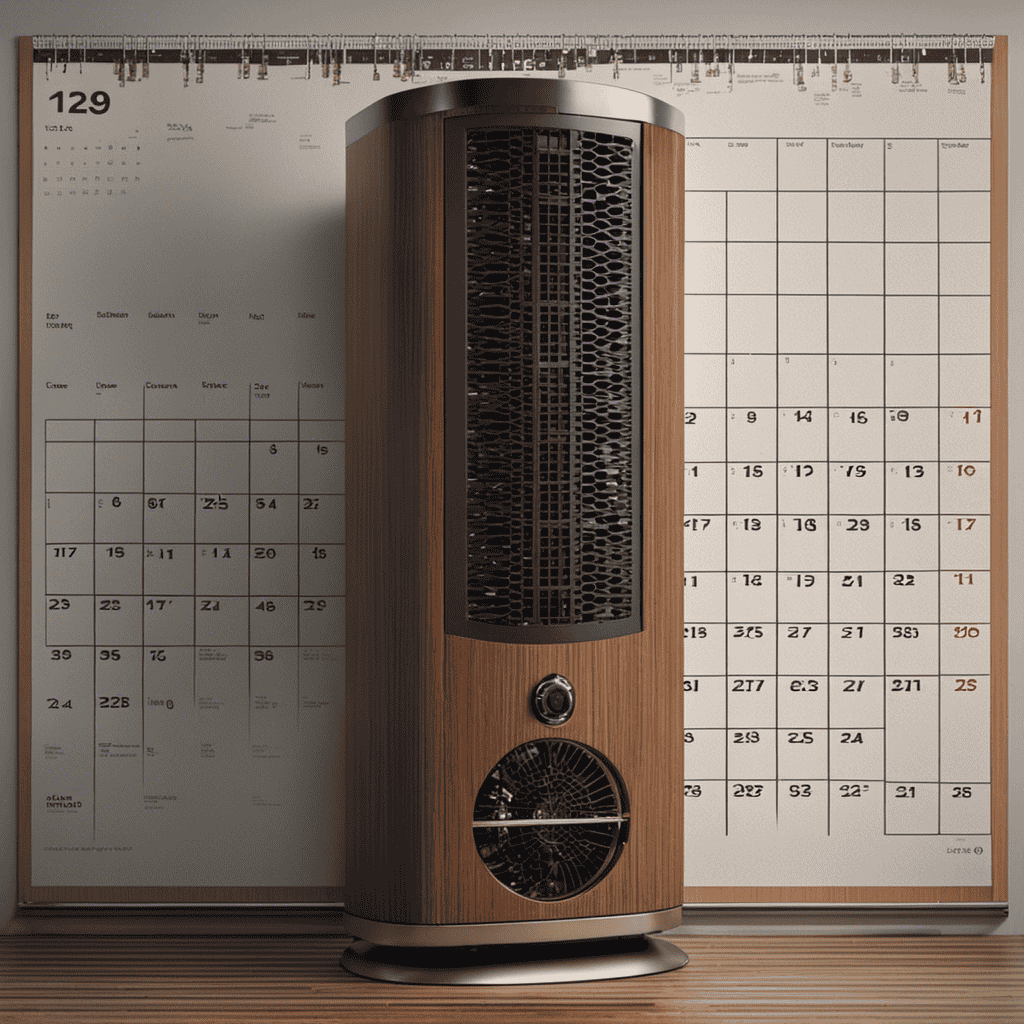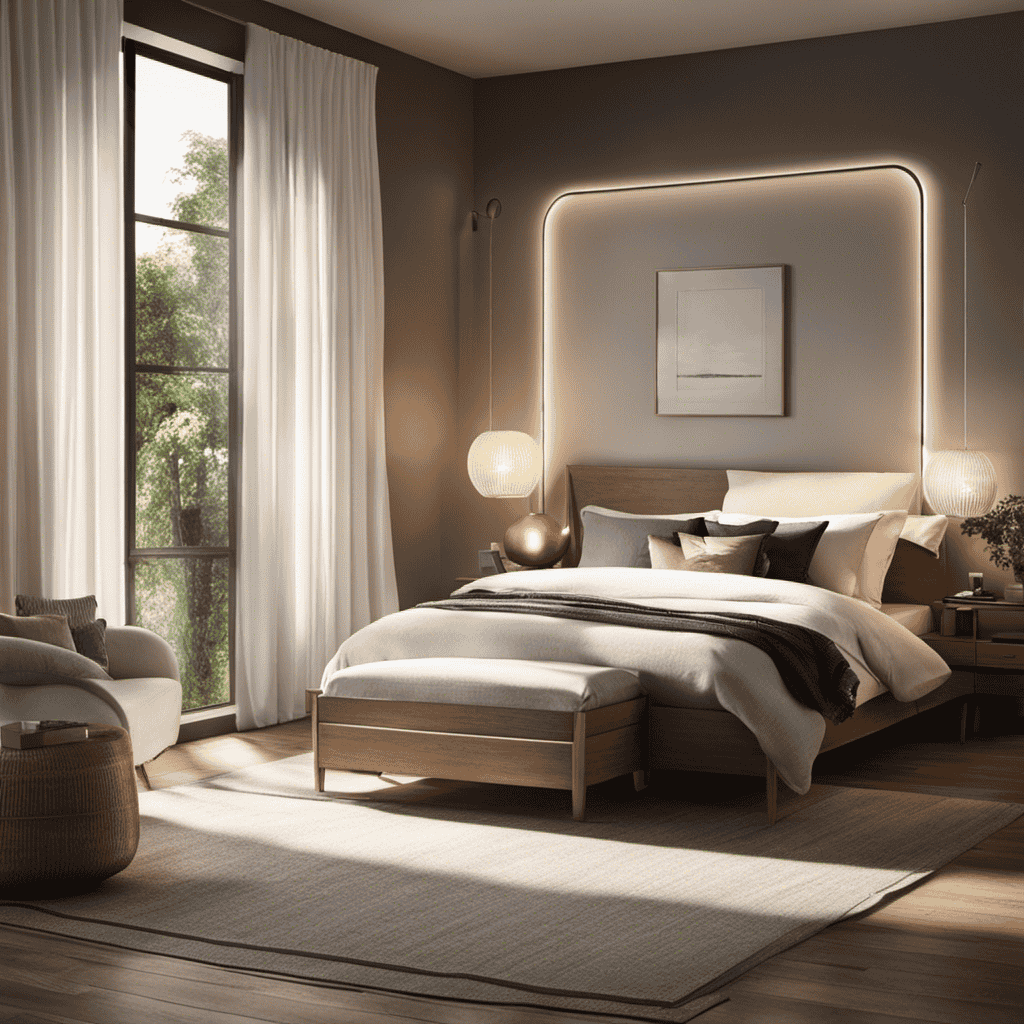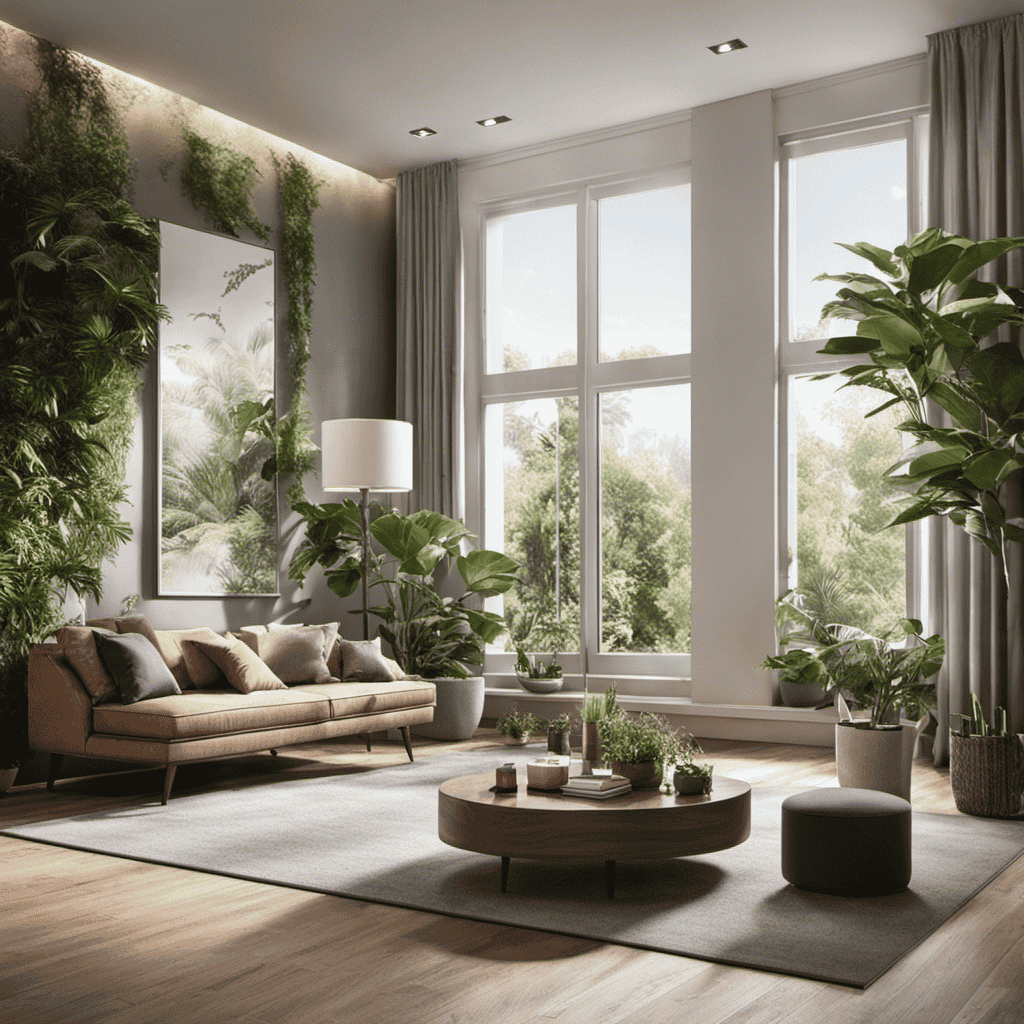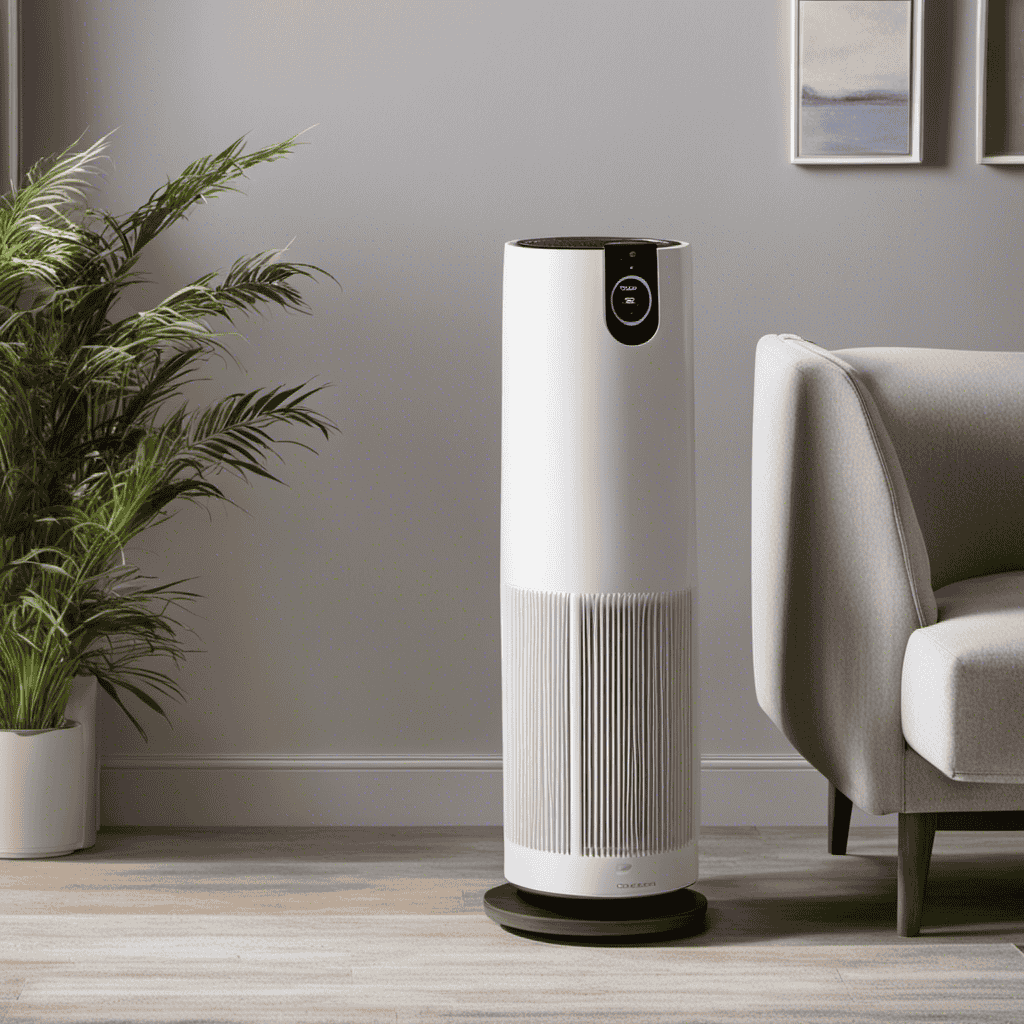As a proud owner of an air purifier, I understand the significance of maintaining clean and fresh indoor air. That’s why knowing the lifespan of an air purifier filter is essential.
In this article, we will dive into the factors that affect the lifespan of these filters and explore the different types available.
I’ll also provide tips on when to replace your filter and signs to look out for.
So, let’s embark on this informative journey together and ensure our air purifiers are working at their best!
Key Takeaways
- The lifespan of an air purifier filter is affected by factors such as the type of filter used, the air quality in the environment, proper maintenance and cleaning, and the efficiency and durability of the filter.
- Different types of air purifier filters, such as HEPA filters, carbon filters, and ionizer filters, have specific functions and should be understood when purchasing an air purifier.
- The frequency of replacing air purifier filters depends on the manufacturer’s recommendations, the type and quality of the filter, and the air quality. Generally, filters should be replaced every 3 to 6 months or when signs of a dirty filter, such as reduced airflow and increased noise, are noticed.
- Proper maintenance, including regular cleaning and following manufacturer’s instructions, can help maximize the lifespan of air purifier filters and ensure optimal performance. Regularly changing filters improves air quality, provides allergy and asthma relief, reduces respiratory issues, and maintains indoor air quality. Neglecting to change filters can reduce effectiveness and pose a risk to health.
Factors That Affect the Lifespan of Air Purifier Filters
There are several factors that can affect how long air purifier filters last. One of the main factors is the type of filter being used. Different filters have varying levels of efficiency and durability.
For example, HEPA filters are known for their high efficiency in removing small particles from the air, but they may need to be replaced more frequently compared to other filter types.
Another factor is the air quality in the environment where the air purifier is being used. If the air is heavily polluted or contains high levels of allergens, the filter may get clogged quicker and require more frequent replacements.
Additionally, proper maintenance and cleaning of the filter can also impact its lifespan. Some common misconceptions about air purifier filters include the belief that they last forever or that they only need to be replaced when visibly dirty. In reality, filters have a finite lifespan and need to be replaced regularly to maintain their effectiveness.
Understanding the Different Types of Air Purifier Filters
Take a moment to familiarize yourself with the various types of filters used in air purifiers. Different air purifier brands utilize different types of filters to remove common air pollutants from your indoor environment. These filters play a crucial role in the purification process and understanding their differences can help you make an informed decision when purchasing an air purifier.
Here is a table outlining three common types of air purifier filters and their features:
| Filter Type | Features |
|---|---|
| HEPA | Highly efficient in capturing particles as small as 0.3 microns. Ideal for capturing allergens, dust, pet dander, and pollen. |
| Carbon | Effective in removing odors, gases, and volatile organic compounds (VOCs). Best suited for eliminating smoke, cooking odors, and chemical fumes. |
| Ionizer | Releases negatively charged ions into the air to attach to airborne particles, making them heavier and causing them to fall to the ground. Can also neutralize bacteria and viruses. |
How Often Should You Replace Your Air Purifier Filter
To ensure optimal performance, you should regularly replace your air purifier’s filter according to the manufacturer’s recommendations.
The frequency of air filter replacement depends on several factors, including the type of air purifier, the quality of the filter, and the air quality in your specific environment.
On average, it is recommended to replace the filter every 3 to 6 months. However, it is important to note that this is just a general guideline, and you should always refer to the manufacturer’s instructions for your specific model.
Signs of a dirty air filter include reduced airflow, increased noise from the purifier, and a decrease in its effectiveness in removing pollutants from the air.
Regularly replacing the filter will ensure that your air purifier continues to function efficiently and effectively.
Signs That Your Air Purifier Filter Needs Replacing
If you notice reduced airflow, increased noise, and less effective pollutant removal, it’s time to replace your air purifier’s filter. Regularly replacing the filter is crucial for maintaining the optimum performance of your air purifier.
Here are three warning signs that indicate your air purifier filter needs replacing:
-
Reduced Airflow: If you notice a decrease in the airflow coming from your air purifier, it could be a sign that the filter is clogged and needs to be replaced. A clogged filter restricts the airflow and reduces the purifier’s efficiency.
-
Increased Noise: A dirty or clogged filter can cause the air purifier to work harder, resulting in increased noise levels. If you notice an unusual increase in noise coming from your device, it’s a clear indication that the filter needs replacing.
-
Less Effective Pollutant Removal: A worn-out filter loses its ability to effectively capture and remove pollutants from the air. If you find that your air purifier is no longer effectively reducing allergens, odors, or other airborne particles, it’s time to replace the filter.
To ensure optimal performance, it is recommended to check the filter replacement frequency specified by the manufacturer and replace the filter accordingly.
Proper Maintenance Tips to Extend the Life of Your Air Purifier Filter
Regularly cleaning and replacing your air purifier’s filter can help prolong its lifespan and maintain its efficiency. Filter maintenance techniques are crucial for ensuring that your air purifier continues to work effectively in removing pollutants from the air.
Cleaning the filter on a regular basis helps to prevent the build-up of dirt and debris, which can reduce the filter’s ability to capture airborne particles. By following the manufacturer’s instructions, you can easily clean the filter using a vacuum or by rinsing it with water. However, it’s important to note that not all filters can be cleaned and may need to be replaced instead.
Prolonging air purifier filter life also involves changing the filter at the recommended intervals to ensure optimal performance. By practicing these maintenance techniques, you can maximize the lifespan of your air purifier filter and enjoy cleaner, healthier air in your home or office.
The Importance of Regularly Changing Your Air Purifier Filter
By neglecting to change your air purifier filter, you risk reducing its effectiveness and allowing pollutants to circulate in your home. Regularly changing your air purifier filter is crucial for maintaining good indoor air quality and protecting your health.
Here are the benefits of using an air purifier at home and the potential health risks of not changing your air purifier filter regularly:
-
Improved air quality: Air purifiers help remove harmful pollutants such as dust, pollen, pet dander, and smoke particles, ensuring cleaner and healthier air for you and your family.
-
Allergy and asthma relief: Changing the filter regularly ensures that the air purifier continues to capture allergens and irritants, providing relief for allergy and asthma sufferers.
-
Reduced respiratory issues: Dirty filters can become clogged, reducing airflow and causing strain on your respiratory system. Regular filter changes prevent this and help maintain optimal airflow.
By understanding the importance of changing your air purifier filter, you can ensure the continued effectiveness of your device and protect yourself from potential health risks.
Now, let’s explore whether air purifier filters can be cleaned and reused.
Can Air Purifier Filters Be Cleaned and Reused
Cleaning and reusing air purifier filters is not recommended as it may compromise their effectiveness in removing pollutants from the air. Air purifier filters are designed to capture and trap airborne particles, such as dust, pollen, and pet dander.
Over time, these filters become clogged with pollutants, reducing their ability to effectively clean the air. Cleaning the filters may remove some of the trapped particles, but it is unlikely to restore their original effectiveness. Additionally, the cleaning process may damage the filter material or cause it to lose its electrostatic charge, further reducing its cleaning effectiveness.
Therefore, it is best to replace air purifier filters when they become dirty or at regular intervals as recommended by the manufacturer.
Now, let’s explore how to choose the right replacement filter for your air purifier.
How to Choose the Right Replacement Filter for Your Air Purifier
When it comes to choosing a replacement filter for your air purifier, there are several effective options available in the market.
The choice of filter depends on various factors such as the specific pollutants you want to remove, the size of your room, and your budget.
Effective Replacement Filter Options
There’s a variety of effective replacement filter options available for air purifiers. When it comes to choosing the right replacement filter for your air purifier, there are a few key factors to consider. Here are three alternative filter options that you may find suitable:
-
HEPA Filters: High Efficiency Particulate Air (HEPA) filters are known for their ability to trap 99.97% of particles as small as 0.3 microns. They are highly effective in removing allergens, dust, pollen, and pet dander from the air. While they may have a higher initial cost, they provide excellent filtration and can last up to 12 months.
-
Activated Carbon Filters: These filters are great for removing odors, chemicals, and volatile organic compounds (VOCs) from the air. Activated carbon has a large surface area that can absorb and trap these pollutants. They are typically replaced every 3-6 months, depending on the level of pollutants in your environment.
-
Electrostatic Filters: These filters use an electrostatic charge to attract and trap particles. They are effective at capturing large particles like dust and pet hair. Electrostatic filters can be washed and reused, making them a cost-effective option in the long run.
When considering replacement filter options, it’s essential to factor in the cost, filtration efficiency, and the specific needs of your environment.
Factors Influencing Filter Choice
To choose the right replacement filter for your air purifier, you should consider factors such as cost, filtration efficiency, and the specific needs of your environment. Several factors can affect the performance of air purifier filters.
First, the size of the filter is crucial. A filter that is too small may not effectively capture all the pollutants, while one that is too large may restrict airflow and reduce filtration efficiency.
Additionally, the quality of the filter material plays a significant role. Filters with higher MERV (Minimum Efficiency Reporting Value) ratings are more effective at removing smaller particles.
Finally, the specific needs of your environment, such as the presence of pets or allergens, should also be considered when choosing a replacement filter.
By considering these factors, you can ensure that you select the most suitable filter for your air purifier.
When it comes to the lifespan of air purifier filters, not all filters are created equal.
Do All Air Purifier Filters Have the Same Lifespan
When it comes to the lifespan of air purifier filters, there is no one-size-fits-all answer. Different filters have varying lifespans, depending on factors such as the type of filter, the air quality in the environment, and the level of usage.
Understanding these factors can help us determine the best practices for maximizing filter longevity and ensuring optimal performance of our air purifiers.
Varying Filter Lifespans
The lifespan of air purifier filters can vary depending on factors such as usage and air quality. It is important to understand the filter replacement frequency and implement proper filter maintenance techniques to ensure optimal performance and longevity. Here are three key points to consider:
-
Filter Replacement Frequency: The manufacturer’s recommendations for filter replacement frequency should be followed. This is typically every 6 to 12 months, but it can vary based on the specific air purifier model and usage patterns.
-
Air Quality: The air quality in your environment plays a significant role in determining the lifespan of your air purifier filter. If you live in an area with high levels of pollutants, allergens, or smoke, the filter may need to be replaced more frequently.
-
Filter Maintenance Techniques: Regularly cleaning and maintaining your air purifier filter can extend its lifespan. Vacuuming or rinsing the filter, as per the manufacturer’s instructions, can help remove accumulated dust and debris, ensuring optimal airflow and efficiency.
Factors Affecting Filter Lifespan
In order to understand the varying lifespan of air purifier filters, it is important to consider the factors that can affect their performance.
Several key factors can impact how long a filter lasts before it needs to be replaced. One of the most significant factors is the quality of the air being filtered. Filters that are exposed to higher levels of pollutants and contaminants will generally have a shorter lifespan compared to those in cleaner environments.
Additionally, the frequency of use and the size of the room being filtered can also influence filter longevity. It is worth noting that the specific type and brand of filter can also play a role.
Understanding the factors that affect filter lifespan can help users make informed decisions when it comes to maintaining the efficiency of their air purifiers.
Transitioning into the subsequent section on best practices for longevity, it is important to implement certain strategies to maximize the lifespan of air purifier filters.
Best Practices for Longevity
To maximize the lifespan of air purifier filters, users can implement certain strategies. By following these maintenance techniques, you can ensure that your filters last longer and continue to provide clean air in your surroundings:
-
Regular Cleaning: Clean the pre-filter and HEPA filter regularly to remove dust and debris that can clog the filters and reduce their efficiency. This can be done by vacuuming or washing the filters as per the manufacturer’s instructions.
-
Filter Replacement: Replace the filters as recommended by the manufacturer. Over time, filters become less effective at capturing pollutants, so it is essential to replace them when they reach their limit.
-
Proper Usage: Use the air purifier in an appropriate space size. Running a small air purifier in a large room will put excessive strain on the filters, reducing their lifespan.
The Role of Filter Efficiency in Determining Lifespan
You’ll want to consider filter efficiency when determining how long an air purifier filter lasts. The efficiency of the filter is determined by its ability to capture and remove particles from the air. Factors such as the type of filter, the size and composition of the particles, and the airflow rate can all influence the filter’s performance. Regular maintenance of the filter is crucial to ensure optimal efficiency and longevity. By regularly cleaning or replacing the filter, you can prevent the buildup of particles and maintain a high level of performance. This not only extends the lifespan of the filter but also improves the overall air quality in your home. Investing in regular filter maintenance is a small price to pay for the benefits of cleaner, healthier air.
| Factors Influencing Filter Performance | Benefits of Regular Filter Maintenance |
|---|---|
| Type of Filter | Improved Air Quality |
| Size and Composition of Particles | Extended Filter Lifespan |
| Airflow Rate | Reduced Allergens and Pollutants |
Can You Use Generic Filters or Should You Stick to Manufacturer’s Recommendations
Using generic filters instead of sticking to the manufacturer’s recommendations can affect the performance and lifespan of your air purifier. While it may seem like a cost-effective solution, there are both pros and cons to using generic air purifier filters.
Pros of using generic filters:
- Cost savings: Generic filters are often cheaper than branded ones, allowing you to save money in the long run.
- Availability: Generic filters are widely available, making it easier to find replacements when needed.
- Compatibility: In some cases, generic filters may be compatible with multiple air purifier models, offering more flexibility in your choices.
Cons of using generic filters:
- Lower quality: Generic filters may not meet the same standards as manufacturer-recommended filters, potentially compromising the efficiency of your air purifier.
- Reduced performance: Generic filters may not capture pollutants as effectively as branded filters, leading to decreased air purification.
- Voided warranty: Using generic filters can void the warranty on your air purifier, leaving you responsible for any repairs or replacements.
Considering these pros and cons, it is important to carefully evaluate the impact of using generic filters on the performance and lifespan of your air purifier.
Understanding the Difference Between HEPA Filters and Carbon Filters
HEPA filters are highly effective at capturing small particles, while carbon filters excel at removing odors and chemicals from the air. When it comes to air purifier maintenance, understanding the difference between these two types of filters is crucial.
HEPA filters use a dense mat of fibers to trap particles as small as 0.3 microns, including pollen, dust mites, and pet dander. On the other hand, carbon filters contain activated charcoal that chemically absorbs and traps odors and harmful chemicals like formaldehyde and volatile organic compounds (VOCs).
By combining these two types of filters in an air purifier, you can ensure that both particles and odors are effectively removed from your indoor air.
Now, let’s explore how long HEPA filters typically last and the factors that can affect their lifespan.
How Long Do HEPA Filters Typically Last
Typically, HEPA filters last for about one to three years before needing to be replaced. However, the actual lifespan of a HEPA filter can be influenced by several factors. Here are three key factors that impact the longevity of HEPA filters:
-
Air Quality: The level of pollutants and contaminants in the air can affect how quickly a HEPA filter becomes saturated and loses its effectiveness. In highly polluted environments, the filter may need to be replaced more frequently.
-
Filter Usage: The frequency and duration of the air purifier’s operation also play a role in filter longevity. Filters may need to be replaced sooner if the air purifier is used for longer periods or runs continuously.
-
Filter Maintenance: Regular maintenance, such as vacuuming or washing the filter, can help extend its lifespan. Neglecting filter maintenance can lead to clogging and reduced efficiency.
Regular filter maintenance offers several benefits, including:
-
Improved Air Quality: Clean filters ensure that the air purifier can effectively remove pollutants, allergens, and particles from the air, resulting in cleaner and healthier indoor air.
-
Energy Efficiency: A clean filter allows the air purifier to operate more efficiently, reducing energy consumption and saving money on electricity bills.
-
Prolonged Appliance Lifespan: By maintaining the filter properly, you can help extend the overall lifespan of your air purifier.
In conclusion, understanding the factors that impact HEPA filter longevity and the benefits of regular filter maintenance can help ensure that your air purifier functions optimally and provides clean air for a longer period.
Now, let’s explore the lifespan of carbon filters and their effectiveness in removing odors.
The Lifespan of Carbon Filters and Their Effectiveness in Removing Odors
When it comes to carbon filters, their effectiveness in removing odors is a key consideration. Carbon filters are highly efficient at adsorbing and trapping odorous molecules, effectively eliminating unwanted smells.
However, it is important to understand that the effectiveness of carbon filters can diminish over time as they become saturated with odor-causing substances. Regular replacement of carbon filters is therefore necessary to maintain optimal odor removal performance.
Carbon Filter Odor Removal
To keep your indoor air smelling fresh and clean, you’ll want to replace the carbon filter in your air purifier regularly. Carbon filters are an essential component of air purifiers as they effectively remove odors and harmful gases from the air. Here are three benefits of using carbon filters for odor removal:
-
Odor neutralization: Carbon filters have a porous surface that absorbs and traps odorous particles, eliminating unpleasant smells from your home.
-
Chemical filtration: Carbon filters are highly effective in removing volatile organic compounds (VOCs) such as formaldehyde, benzene, and toluene, which can be found in household products and contribute to indoor air pollution.
-
Improved air quality: By removing odors and chemicals, carbon filters help improve the overall air quality in your home, reducing the risk of respiratory issues and allergies.
Regular maintenance of carbon filters ensures their efficiency in odor removal. But how long do they remain effective? Let’s explore this in the next section.
How Long Effective
If you want to know how effective a carbon filter is, you should consider factors such as usage, air quality, and maintenance. These factors can greatly affect the efficiency of a carbon filter and its ability to remove odors and contaminants from the air.
Below is a table that outlines the factors affecting the efficiency of a carbon filter:
| Factors Affecting Efficiency | Description |
|---|---|
| Usage | The frequency and duration of filter usage. |
| Air Quality | The level of pollutants and odors in the air. |
| Maintenance | Regular cleaning and replacement of the filter. |
To ensure the longevity and effectiveness of your carbon filter, here are some maintenance tips:
- Clean or replace the filter regularly according to the manufacturer’s instructions.
- Keep the surrounding area clean and free from dust and debris.
- Monitor the air quality and adjust the usage of the filter accordingly.
Replacing Carbon Filters?
When it comes to carbon filters, their lifespan can vary depending on several factors. Here are a few key points to consider:
-
Carbon filter lifespan: Activated carbon filters typically last between 6 to 12 months, depending on the level of air pollution and usage. However, this can vary based on the manufacturer’s recommendations and the specific air purifier model.
-
Signs of replacement: It’s essential to monitor the performance of your carbon filter regularly. When it starts to lose its effectiveness, you may notice a decrease in odor reduction or an increase in dust particles in the air. These are signs that it’s time to replace your carbon filter.
-
Replacing activated carbon filters: To ensure optimal performance, it’s crucial to replace your activated carbon filter as recommended by the manufacturer. Follow the instructions provided with your air purifier to safely and correctly replace the filter.
Tips for Properly Storing and Handling Spare Air Purifier Filters
Make sure you store and handle your spare air purifier filters properly to ensure their longevity. Proper storage and filter handling are essential in maintaining the effectiveness of your filters.
When storing your spare filters, it is important to keep them in a cool, dry place away from direct sunlight. Exposure to extreme temperatures or humidity can degrade the filter material and reduce its efficiency. Additionally, avoid bending or crushing the filters, as this can damage the fibers and affect their ability to capture pollutants.
When handling the filters, always wash your hands before touching them to minimize the transfer of dirt and oils.
Frequently Asked Questions
Are There Any Alternative Methods to Prolonging the Lifespan of an Air Purifier Filter Without Proper Maintenance?
To prolong an air purifier filter’s lifespan without proper maintenance, alternative methods include regular vacuuming, using pre-filters, and keeping the surrounding area clean. These practices can help reduce the accumulation of dirt and extend the filter’s effectiveness.
Can Using a Generic Filter in My Air Purifier Affect Its Performance or Lifespan?
Using alternative filter options or expired filters can negatively impact an air purifier’s performance and lifespan. It’s crucial to use the recommended filter and replace it regularly to maintain optimal air quality.
How Do HEPA Filters and Carbon Filters Differ in Terms of Lifespan and Effectiveness?
Hepa filters generally last longer than carbon filters, but carbon filters are more effective at removing odors and chemicals. It’s important to consider both lifespan and effectiveness when choosing the right filter for your air purifier.
What Are the Signs That Indicate a Carbon Filter Needs Replacement Specifically for Odor Removal?
When it comes to replacing a carbon filter for odor removal, there are a few signs to look out for. These include a decrease in the filter’s effectiveness and a noticeable increase in odors. To extend the lifespan of your air purifier filter without maintenance, consider using an activated carbon pre-filter.
Are There Any Specific Guidelines for Storing and Handling Spare Air Purifier Filters to Ensure Their Effectiveness When Used in the Future?
When it comes to storing and handling spare air purifier filters, it’s crucial to follow specific guidelines to ensure their effectiveness in the future. Proper storage and handling can extend the lifespan of filters and maintain their optimal performance.
Conclusion
In conclusion, the lifespan of an air purifier filter is influenced by various factors. These factors include air quality, usage time, and filter type. Understanding the different types of filters, such as HEPA and carbon filters, is crucial in determining their longevity and effectiveness.
Regularly replacing filters and properly maintaining them can significantly extend their lifespan. By doing so, you can ensure that your air purifier filter is like a knight protecting a castle. It diligently guards your indoor air quality, ensuring a fresh and clean environment for you and your loved ones.










